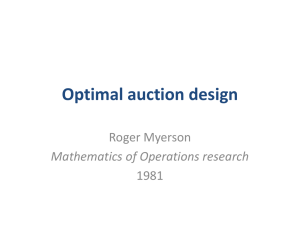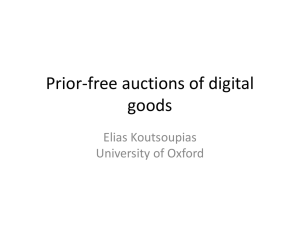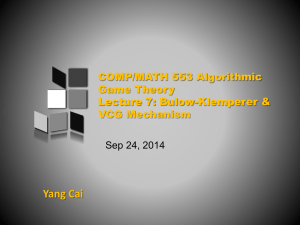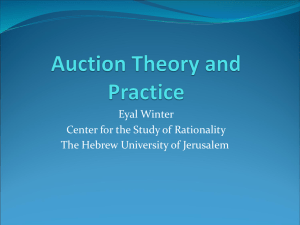pptx - Peter Cramton - University of Maryland
advertisement
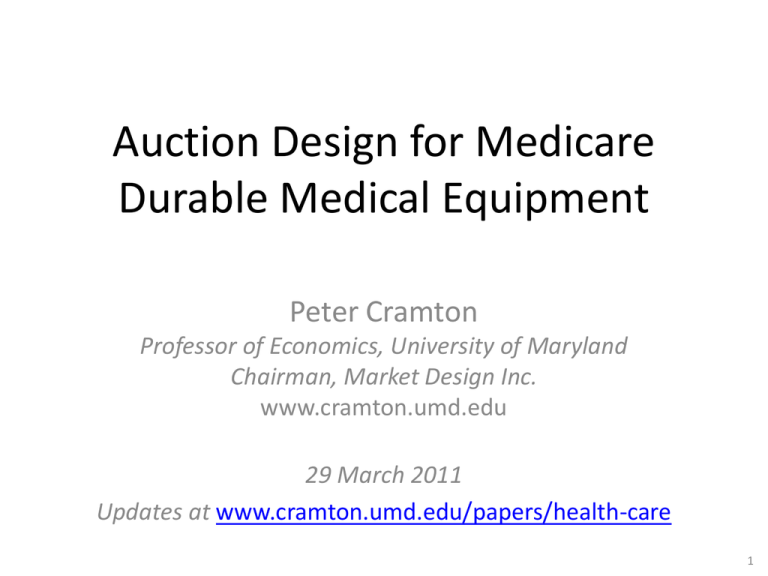
Auction Design for Medicare Durable Medical Equipment Peter Cramton Professor of Economics, University of Maryland Chairman, Market Design Inc. www.cramton.umd.edu 29 March 2011 Updates at www.cramton.umd.edu/papers/health-care 1 Motivation 2 Unfunded Medicare expenses About $70 Trillion! 3 Diabetes Medicare costs Managing health at home and keeping out of the hospital is essential to controlling costs 4 CMS design flaws 5 An efficient “clearing-price auction”: demand = 7; price = 8th lowest bid This is how markets work; it is the most common auction format. Inefficient CMS auction: demand = 7; price = 4th lowest bid This CMS design has never been used anywhere. Median pricing rule together with non-binding bids creates strong incentive for low-ball bids • Submitting a low-ball bid is a good strategy – Bid has a negligible impact on the price paid – Gives the bidder the option to sign a supply contract if the price is sufficiently attractive • Adverse selection: Low-ball strategy especially attractive for – Small and less informed bidders who don’t have the time or resources to adopt a more sophisticated strategy – Desperate bidders on verge of bankruptcy – Low-quality bidders more apt to engage in fraud or corruption • If more than 50% of the bidders (by number, not volume) submit low-ball bids, then the price will be unsustainably low, leading to shortages, poor service, fraud and corruption • Prices are not related to costs 8 Lack of transparency • Unclear how bidder quantities are determined – Critical input in pricing and winner determination – Pricing becomes arbitrary decision of CMS • Winners not disclosed until 1 year after bids taken in November 2009 • Unclear quality standards • Unclear performance obligation • Lack of transparency makes auction vulnerable to litigation (see http://goo.gl/utfIq) 9 Pricing is arbitrary, since bidder quantities determined in non-transparent way by CMS Price $30 $28 $26 $24 $22 $20 $18 $16 $14 $12 $10 $8 $6 $4 $2 $0 Demand $25 $23 $21 $19 $17 $15 $13 $11 Median $9 $7 $5 $3 20 40 60 80 100 120 140 160 180 200 220 240 Quantity Median = $7 when CMS does not discount quantities at all. 10 Pricing is arbitrary, since bidder quantities determined in non-transparent way by CMS Price $30 $28 $26 $24 $22 $20 $18 $16 $14 $12 $10 $8 $6 $4 $2 $0 Demand $25 $23 $21 $19 Median $12 $17 $15 $13 $11 $9 $7 $5 $3 10 20 30 40 50 60 70 80 90 100 110 120 Quantity Median = $12 when CMS discounts quantities by 50%. 11 Evidence of program failure extremely strong • Theory – Equilibria of CMS auction are at best strategically chaotic – Most plausible equilibrium results in complete market failure • Experiment – Lab experiments at Caltech clearly demonstrate poor performance in a simplified environment – Lab experiments at Maryland further demonstrate poor performance in additional environments • Field – Experience with pilots in 2008 and 2009 suggests failure 12 Part 1: Summary Competitive bidding can result in large cost reductions without sacrificing quality, but it must be done right! 13 Proposed design addresses flaws in CMS program • Bids are binding commitments – Each bid binds the bidder to particular performance obligations depending on the auction outcome – Bids are made credible through • Rigorous qualification one month before auction • Bid bond proportional to bidder’s capacity – Returned to losing bidders at end of auction – Returned to winning bidders after posting performance guarantee • Performance bond proportional to a winner’s capacity – Returned when performance obligation met – Financial guarantees add a modest cost but protect legitimate HME providers from being crowded out by poor or fraudulent suppliers • Engages competitive banking market in financial review • Banking and capital markets determine worthy providers, not CMS • Auction establishes market clearing price for each item defined by product and region – Price paid to all providers is the clearing price that balances supply and demand – Prices found in a simple price discovery process that allows for both substitution and complementarities across categories – Prices are not capped at current levels HME = Home Medical Equipment = DME; CMS = Centers for Medicare & Medicaid Services 14 Capacities based on historic supply • Each existing provider is assigned a capacity based on its supply for category and region in prior 3 years, with most recent year given most weight (one block of capacity is about 1 percent of total volume) • Each qualified new provider is assigned a capacity of 1 block (about 1 percent) • Variation: the number of blocks can vary from 100 to 200 depending on the product-region to allow for different market sizes and minimum efficient scales • Any provider may supply more than its capacity, but its capacity is assumed in matching supply and demand and in setting performance obligations • Capacities are determined in objective manner 15 Auction competition comes from new entrants • Since capacities of existing providers are set to equal approximately 100 blocks (100% of demand), excess supply comes from the desire of new entrants to supply at the current auction price • The price keeps declining until new entrants are unwilling to supply or a sufficient quantity of existing providers exit the market to offset the new entry • Given relatively low entry costs, especially from providers supplying in other regions or other categories, ample new entry can be expected at prices above competitive levels • Financial guarantees assure bidders exit at prices below competitive levels 16 Winning bidders and prices • As soon as supply falls to 100 blocks or less, the clearing price is set at the exit bid of the bidder that caused supply to fall to 100 or less • Each bidder still in wins its capacity • If supply is less than 100 blocks, the blocks won is scaled up to 100/Supply Example: If with supply at 101, a bidder with 10 blocks exits at $34 and supply falls to 91; the clearing price is $34; and block won are scaled-up by 100/91 • If multiple bidders exit at the clearing price, then exits are accepted to minimize the shortfall from 100 blocks (larger bidders first in event of tie) 17 Post-auction competition motivates quality • After the auction, the winners compete for Medicare beneficiaries by offering quality products and services • An HME provider offering better quality will increase market share, which will lead to a higher capacity in future auctions • Medicare beneficiary choice is not only maintained but is an important driver to motivate providers to provide high quality products and services 18 Prices of individual products are relative to the price of the lead product in the category • For each category, lead product is the product with the greatest dollar volume based on 2009 data or greatest correlation with cost of other products in category • In qualification stage, for each category of interest, the bidder reports the relative price of each product as a percentage of the lead product’s price • The auctioneer computes the relative price index for the category as the capacity-weighted average of the bidder reports • The auction determines the price of each lead product in each category; other individual product prices are determined from the relative price index – Example: Oxygen concentrator = $100; portable gas cylinders have a relative price of 15%, so are priced at $15 19 Optimization of categories, products, and regions • As a result of medical innovation, new products will be introduced and some old products will be eliminated – This evolution of products to conform to state-of-the-art practices is essential • Regions are an aggregation of adjacent counties within a particular state for which cost factors are quite similar • Product categories are defined to include a set of highly complementary products • Absolute prices for products within a particular category should tend to move together – If they do not, then the category should be split into multiple categories that do share within-category price movement • Product categories, products, and regions should be re-optimized for the new auction approach – The approach can easily accommodate more product categories, products, and regions – Optimization of categories, products, and regions is an essential task in the product design step with major input from HME providers 20 Version 1: 100% auctioned on rotating basis • Each year one-third of regions are auctioned with 3-year contracts – 3 groups of regions (West, Central, East) • Structure facilitates capture of geographic complementarities – 1 group auctioned each year – Establishes competitive prices in area for 3 years – Losers are excluded from supply in area • Provides incentive to stay in auction • Variation: each year one-half of regions are auctioned with 2year contracts – Shorter commitment period encourages flexibility and entry • In either case, contract commitment extends to term of agreement with individual patients – Example: In last month of contract, provider supplies hospital bed to patient under 12-month rental agreement; provider is committed to patient regardless of whether the provider wins a supply contract in the next round 21 Preferred variation: Auction a representative 10% each year • Approach does not disrupt market structure – Emphasis is on establishing competitive prices, rather than excluding suppliers Apply competitive bid-based prices to non-auctioned areas – Auction a representative 10% of regions each year • Auction establishes prices in remaining 80% with a simple econometric model based on the two most recent auctions • Each year a different 10% is used, so over 10 years each region is auctioned once – In auctioned regions, only winners can supply during the two-year commitment period • Winners still must compete within the region – Any certified supplier can supply in any non-auctioned region (80% of country) 22 Auction is easy for bidders • Price process is easy for bidders to manage – Bidders interested in a particular category can focus on that category in all areas – Bidders interested in a particular region can focus on that area in all categories – Bidders with other interests can focus on the most relevant categories and areas for them • Auction completes in a single day (or perhaps two for initial auction) • Auction system is easy to use and requires no special software; a modern browser is all that is required • Proxy bids allow small bidders to bid as in a sealedbid auction 23 Auction is highly transparent • Qualification and financial guarantees are reported publicly well in advance of the auction • Capacities determined in objective manner • Auction rules including product definitions, performance obligations, and penalties are known two months before auction • Following each bidding round, excess supply at current prices as well as prices for next round are publicly announced • Winners and quantity won are immediately announced at the conclusion of the auction • The auction results are certified by CMS within 48 hours of the auction end • An independent market monitor reports on auction outcome and any problems within two weeks of auction end 24 Proposed design based on proven methods • Clearing price approach used almost universally across all countries and industries – Clearing price balances supply and demand – Leads to efficient assignment of supply to demand • Simultaneous descending clock format has outstanding price discovery – Allows simple arbitrage across substitutes – Allows acquisition of a complementary portfolio of product categories – Efficiently aggregates information among many bidders to reduce the possibility of winner’s curse – Approach proven in hundreds of auctions for spectrum, electricity, gas, diamonds, emission allowances, etc. 25 Proposed design based on proven methods • Bidders are bound by bid bonds and performance bonds to guarantee the integrity of the bidding, as in all well run auctions • Relative price index used to 1) assure bidders win complementary within-category products and 2) greatly simplify auction and improve liquidity – Approach use with great success in rough diamond auctions (BHP Billiton, since 2008) and electricity auctions (EDF, since 2001) • Transparent auctions commonly used in highly successful government auctions – FCC spectrum auctions, since 1994 – Electricity auctions regulated by FERC, since 1998, in CAISO, ERCOT, ISO-NE, Midwest ISO, NY ISO, PJM – Emission auctions conducted by RGGI (carbon), since 2008 • In sharp contrast, the CMS design with non-binding bids and the median pricing rule has never been used in any country or industry 26 How best to get to the long-run solution? • Transition to an efficient auction as soon as possible – Substantial evidence that prices from November 2009 are erroneous • • • • Theory (Cramton and Katzman 2010) Caltech experiments (Merlob et al. 2010) CMS red flags about program integrity Radical change in market structure (Cramton 2010) – Savings will be greatest the sooner we move to a sustainable auction that identifies competitive prices and least-cost suppliers 27 How best to get to the long-run solution? • Design automatically starts small even though it is applied nationwide – Only a small fraction of regions auctioned each year • With prompt action by CMS first auction could take place in fourth quarter 2011 for 1 January 2012 start – Well-designed auction greatly reduces staff time spent on • Addressing disputes • Managing fraud and abuse • Putting out fires – Well-designed auction enables CMS staff to focus on critical tasks of • Qualification • Guarantees • Performance monitoring 28 Next step: Medicare auction conference • An opportunity for collaboration among – – – – – DME providers Medicare beneficiaries Government agencies (HHS, CMS, CBO, OMB, CEA) Congressional staff Auction experts • Key goals – To discuss key issues of an auction approach – To demonstrate how an efficient auction works – To debate the merits of the auction approach 29 Medicare auction conference • Sponsors – National Science Foundation – University of Maryland • Date and venue – 8:30am to 5pm, Friday, 1 April 2011 – Inn and Conference Center, University of Maryland College Park MD – About 110 participants (40 government, 70 non-government) 30 Medicare auction conference: Outline • • • • • • • • • • • Registration and Breakfast (8am) Welcome (8:30am) – Peter Cramton, Professor of Economics, University of Maryland – Jonathan Blum, Deputy Administrator, CMS A proposed auction approach for Round 2 (9am), Peter Cramton – How it works – Why it addresses the problems of the current CMS approach (Round 1 Rebid) Morning break (9:45am) Auction demonstration (10:15am), Peter Cramton and Larry Ausubel, University of Maryland A mock auction is conducted with all participants using the proposed rules and a commercial auction platform. Each team is given a specific business plan and asked to maximize profits. There are four steps: – Description of the mock auction environment – Description of the auction platform and the mechanics of bidding – Running of the auction (first few rounds) Lunch (12:15pm) occurs after approximately 1 or 2 rounds of bidding Running of the auction (remaining rounds) (1:15pm) Presentation of auction results First panel: Sustainability, market structure, and beneficiary choice (2:15pm) Moderated by Lance Leggitt, Chair, Federal Health Policy, Baker Donelson Paul Gabos, Chief Financial Officer, Lincare Amy Law, Vice President Government and Healthcare Strategy, KCI, Inc. Nancy Lutz, Program Director, Economics, National Science Foundation Joel Marx, Chairman, Medical Service Company Zachary Schiffman, President, United States Medical Supply 31 Medicare auction conference: Outline • • • • • • • • Afternoon break (3pm) Second panel: Product design and ensuring performance (3:30pm) Optimization of products and regions Financial guarantees (bid and performance bonds or deposits) Moderated by Thomas Milam, Member of Program Advisory and Oversight Committee (PAOC) Cara Bachenheimer, Senior Vice President Government Relations, Invacare Corporation Michael Iskra, Chief Operating Officer, Simplex Healthcare Scott Lloyd, Co-founder and President, Extrakare LLC Mike Pfister, Executive Vice President Government Affairs, The SCOOTER Store John Shirvinsky, Executive Director, Pennsylvania Association of Medical Suppliers Final panel: What have we learned? (4:15pm) Moderated by Peter Cramton, Professor of Economics, University of Maryland Tom Bradley, Chief, Medicare Cost Estimates, Congressional Budget Office Walt Gorski, Vice President, Government Affairs, American Association for Homecare Nancy Johnson, 24-year Congresswoman (R-CT), Senior Public Policy Advisor, Baker Donelson Thomas Kruse, President and CEO, Hoveround Corporation Evan Kwerel, Senior Economic Advisor, Federal Communications Commission Wayne Sale, Chairman, NAIMES, and President and CEO, Health First Conference end (5pm) 32 Part 2: Why competitive pricing? Why is this important? 33 Why use an Auction? • Discover market prices in a transparent bidding process • Efficiently allocate supply across providers 34 Why is this important? • Many tens of trillions in unfunded Medicare costs • Managing costs and enhancing services is essential as our population ages 35 CMS has a poor record with auctions • For 25 years, CMS/HCFA have attempted to implement competitive pricing to Medicare • Only one program (Part D Payment System in 2003) appears successful; rules mandated by Congress • All 9 other programs have ended in failure • If CMS has another failed program, essential pricing reforms likely to be stalled or eliminated Source: Robert F. Coulam, Roger Feldman, and Bryan E. Dowd, Bring Market Prices to Medicare: Essential Reform at a Time of Fiscal Crisis, AEI Press, November 2009. 36 Cost analysis for Medicare reimbursed power wheelchairs (pre-competitive bidding) Source: Estimates by a major DME provider, Nov 2010. Potential cost savings through reduced supplier Medicare overhead from advanced IT and other efforts to minimize transaction costs CMS should work collaboratively with suppliers to reduce Medicare overhead, saving 25% or more; these savings are independent of the auction. Source: Estimates by a major DME provider, Nov 2010. Part 3: Market design 39 Three steps to market design 1. Product design – What is being auctioned? 2. Auction design – How it is being auctioned? 3. Transition – How to get from where we are to where we need to be? • In all three it is important to engage collaboratively – CMS (the administering agency) – Auction experts – Market participants • Medicare providers • Medicare beneficiaries 40 Objectives 41 Purpose of market • • • • Efficient price formation and allocation Transparency Neutrality Simplicity 42 Efficient price formation and allocation • • • • Prices based on market fundamentals Supply awarded to least-cost providers Sustainable competitive market structure Avoidance of fraud and corruption 43 Transparency • • • • Offers are comparable Clear why winners won and losers lost Prompt regulatory review and approval Regulatory certainty 44 Neutrality • All providers treated equally – And know that they are treated equally • All demanders (beneficiaries) treated equally 45 Simplicity • For participants • For regulator • For auction administrator 46 An efficient auction achieves all these objectives • • • • Efficient price formation and allocation Transparency Neutrality Simplicity 47 Part 4: Additional CMS design flaws 48 Use of composite bid creates strong incentives for bid skewing • Bid lower on products where CMS overestimated demand • Bid higher on products where CMS underestimated demand • Prices are not related to costs 49 Exposure problem • Sealed-bid auction exposes the bidder to winning only some of the categories the bidder needs for its business plan • Service complementarities are lost across categories 50 Race to the bottom • • • • Given these flaws, likely outcome is: Providers become increasingly unreliable Service quality worsens Selective fulfillment of customer orders as a result of poor pricing process • Elimination of most current providers in Round 1 Rebid is strong evidence of significant problems (see http://goo.gl/j89lL) 51 Part 5: Design features 52 Simple and effective: Simultaneous descending clock auction • One price clock for each product category and region • Prices initially set high (well above the current caps) • For each category and region, bidder says “in” or “out” – If “out”, bidder provides an exit bid indicating the price the bidder wishes to drops out of the category – Once a bidder drops out of a category, the bidder cannot return to the category • Auctioneer lowers the price on each category for which there is excess supply • Bidders again respond with “in” or “out” • Process continues until supply and demand balance for all product categories 53 Capacities based on historic supply • Each existing provider is assigned a capacity based on its supply for category and region in prior 3 years Capacity 47 Qyear 1 27 Qyear 2 17 Qyear 3 Qy = volume in category supplied in year y as a percentage of the total volume Capacity is rounded to the nearest whole number of blocks (1 block = 1 percent; variation: 1 block = ½ percent) More weight is given to more recent years • Each qualified new provider is assigned a capacity of 1 block (1 percent ; variation: 1 block = ½ percent) • Variation (1 block = ½ percent) allows more new entry by small businesses • Any provider may supply more than its capacity, but its capacity is assumed in matching supply and demand and in setting performance obligations • Capacities are determined in objective manner 54 Version 1: 100% auctioned on rotating basis • Each year one-third of regions are auctioned with 3-year contracts – 3 groups of regions (West, Central, East) • Structure facilities capture of geographic complementarities – 1 group auctioned each year – Establishes competitive prices in area for 3 years – Losers are excluded from supply in area • Provides incentive to stay in auction • Variation: each year one-half of regions are auctioned with 2year contracts – Shorter commitment period encourages flexibility and entry • In either case, contract commitment extends to term of agreement with individual patients – Example: In last month of contract, provider supplies hospital bed to patient under 12-month rental agreement; provider is committed to patient regardless of whether the provider wins a supply contract in the next round 55 An example with 100 regions and 3-year contracts Group the 100 regions into 3 groups West Central East W00 W10 W20 C00 C10 C20 C30 E00 E10 E20 W01 W11 W21 C01 C11 C21 C31 E01 E11 E21 W02 W12 W22 C02 C12 C22 C32 E02 E12 E22 Auction Contract West Nov 2011 2012-14 Central Nov 2012 2013-15 East Nov 2013 2014-16 W03 W13 W23 C03 C13 C23 C33 E03 E13 E23 W04 W14 W24 C04 C14 C24 C34 E04 E14 E24 W05 W15 W25 C05 C15 C25 C35 E05 E15 E25 W06 W16 W26 C06 C16 C26 C36 E06 E16 E26 W07 W17 W27 C07 C17 C27 C37 E07 E17 E27 W08 W18 W28 C08 C18 C28 C38 E08 E18 E28 W09 W19 W29 C09 C19 C29 C39 E09 E19 E29 56 An example with 100 regions and 2-year contracts N00 N01 N02 N03 N04 N05 N06 N07 N08 N09 Group Auction Contract N10 N11 N12 N13 N14 N15 N16 N17 N18 N19 North Nov 2011 2012-14 North N20 N21 N22 N23 N24 N25 N26 N27 N28 N29 South Nov 2012 2013-15 N30 N31 N32 N33 N34 N35 N36 N37 N38 N39 N40 N41 N42 N43 N44 N45 N46 N47 N48 N49 S00 S01 S02 S03 S04 S05 S06 S07 S08 S09 S10 S11 S12 S13 S14 S15 S16 S17 S18 S19 South S20 S21 S22 S23 S24 S25 S26 S27 S28 S29 S30 S31 S32 S33 S34 S35 S36 S37 S38 S39 S40 S41 S42 S43 S44 S45 S46 S47 S48 S49 57 Preferred variation: Auction a representative 10% each year • Approach does not disrupt market structure – Emphasis is on establishing competitive prices, rather than excluding suppliers Apply competitive bid-based prices to non-auctioned areas – Auction a representative 10% of regions each year • Auction establishes prices in remaining 80% with a simple econometric model based on the two most recent auctions • Each year a different 10% is used, so over 10 years each region is auctioned once – In auctioned regions, only winners can supply during the two-year commitment period • Winners still must compete within the region – Any certified supplier can supply in any non-auctioned region (80% of country) 58 An example with 100 regions and 2-year contracts Group the 100 service areas into 10 groups Each group is representative of the diversity of service areas Auction Contract 2g 1f 8f 2d 5d 4i 3d 3j 9e 10d Group 1 Nov 2011 2012-13 7a 5j 6i 5g 7c 6a 10f 1e 6f 3h Group 2 Nov 2012 2013-14 1a 7b 6g 4a 9i 1i 6h 1g 7i 6j Group 3 Nov 2013 2014-15 4f 9f 2j 4h 3f 3i 7f 2c 1d 3a Group 4 Nov 2014 2015-16 7d 10a 10c 10g 8g 8i 7g 4d 8e 2i Group 5 Nov 2015 2016-17 1j 5f 9h 4g 8c 10h 2a 8h 5h 10j Group 6 Nov 2016 2017-18 9d 8a 4c 9g 6b 4e 2h 10b 7e 10e Group 7 Nov 2017 2018-19 6e 7h 2e 5i 3g 6c 5b 1c 4b 3e Group 8 Nov 2018 2019-20 2f 9b 5c 9a 7j 8j 4j 10i 3c 8b Group 9 Nov 2019 2020-21 6d 1b 5e 3b 5a 8d 9c 1h 2b 9j Group 10 Nov 2020 2021-22 59 Auction is especially easy for small bidders • Auction allows proxy bids so that the bidder does not have to participate in multiple rounds – Bidder can submit its best bids in round 1 (or later subject to activity rule) if the bidder does not need to take advantage of price discovery – This keeps the bidder in until its best bid is reached, just as in eBay – The a smaller bidder interested in only 3 product categories in 1 region would only need to submit 3 numbers in the auction stage – Bidding is as easy as using an ATM machine 60 Design accommodates other considerations • Market structure – It is common to include a market share constraint, such as no provider can bid for more than 20 blocks (20%) of any item – A preference for small businesses can be applied, such as a requirement that at least 20 blocks of any item be won by small businesses • Likely not necessary given current market structure • However, if the constraint does bind for an item, then the auction would result in a lower price for small businesses • Participation by small businesses is encouraged, since small businesses know that at least 20 blocks will be awarded to small businesses – These constraints assure a diversity of winners, consistent with long-run sustainable competition 61 Part 6: Experimental evidence from An Evaluation of the Proposed Procurement Auction for the Purchase of Medicare Equipment: Experimental Tests of the Auction Architecture Brian Merlob, Kathryn Peters, Charles R. Plott, Andre Pradhana and Yuanjun Zhang California Institute of Technology Preliminary Draft, 17 November 2010 62 Caltech experiments • Experimental methods allow researchers to scientifically test alternative auction designs • Experiments conducted in state-of-the-art experimental labs at – California Institute of Technology – University of Maryland • Experiments conducted using state-of-the-art experimental methods • Performance of CMS auction design is tested in comparison with the clearing price auction 63 Many different treatments were done. Demand = 7 units in all treatments. Either 12 or 16 bidders, each with unit supply. Either clearing-price auction (first excluded bid, a.k.a. VCG auction) or CMS auction (median price with cancellation). Cost is either private information or bidders have full information. In a few treatments, the bidder must pay a small fee to bid. Six typical treatments are presented here. Your cost is drawn randomly and is your private information. Treatment 1 Your cost is drawn randomly and is your private information. Clearing-price Auction Treatment 2 Your cost is drawn randomly and is your private information. CMS Auction CMS auction results in shortages (or poor quality); clearing-price auction always procures full demand Supply = Demand Shortages and selective fulfillment 67 CMS auction yields the wrong prices; clearing-price auction yields efficient prices Competitive equilibrium prices Unsustainably low prices 68 CMS auction highly inefficient; clearing-price auction fully efficient Full efficiency Poor efficiency 69 Strong tendency to bid true cost in clearingprice auction, since it is a dominant strategy 70 Bids in CMS auction are often well above cost and often at smallest allowed bid Low-ball bids 71 When we add bidders (16 rather than 12), CMS auction performs even worse Low-ball bids 72 With more bidders, CMS auction is more apt to result in complete market failure Complete market failure 73 Unsustainable prices 74 Efficiency falls substantially as we add bidders Poor efficiency 75 With CMS auction, outcomes get worst over time 76 With CMS auction, outcomes get worst over time 77 Part 7: Field evidence round 1 rebid Compiled by Peter Cramton, 9 Dec 2010. Provider volumes in 2007-08 from the Medicare 5% Limited Data Set (5%LDS) Standard Analytic File (SAF). Providers with a claim count of ten or less were aggregated into “Other” per Medicare privacy requirements. Winning providers from CMS. 78 Change in market structure from round 1 rebid; 2008 market share shown Existing providers that won a contract in region for product category Existing providers that did not win a contract in region for product category 79 Change in market structure from round 1 rebid; 2008 number of providers Existing providers that won a contract in region for product category Existing providers that did not win a contract in region for product category New providers that won a contract in region for product category “If they have never billed Medicare for diabetic test strips, how could they possibly prepare a legitimate bid for diabetic supplies?” – Diabetes Incumbent of 11-years 80 Market share in 2007-08 and round 1 rebid status Mail-order Diabetic Supplies in Riverside-San Bernardino-Ontario, CA Existing providers that won a contract in region for product category Existing providers that did not win a contract in region for product category See Peter Cramton, “Medicare Auction Failure: Early Evidence from the Round 1 Rebid” for charts for other categories and regions. 81 Evidence of potential fraud and poor service • An analysis of the 359 contract winners by Invacare, the largest U.S. manufacturer of home medical equipment (and largest creditor to the HME community), found “34 Percent Medicare HME Bid Program Contractors Are Not Financially Viable ” – 8.5 percent have credit limits < $10,000 – 5.4 percent are on credit hold – 6.7 percent are so far behind that their accounts have been turned over for collections or legal process – 14 percent have no account with Invacare Source: Invacare announcement, 1 December 2010 82 Part 8: Further details 83 Setting 84 Medicare DME Market • 354 products in 8 broad categories Category Products Oxygen 12 Standard mobility devices 106 Complex mobility devices 123 Mail order diabetic supplies 8 Enternal nutrients and supplies 17 CPAP and respiratory devices 40 Hospital beds 31 Walkers 17 Total 354 85 Medicare DME Market • Top-20 products by 2009 reimbursement Share of Reimbursement Beneficiaries Beneficiaries Product Rank Reimbursement ($M) total (k) allowed (k) Blood glucose/reagent strips (A4253) 1 27% 701 2,849 2,768 Oxygen concentrator (E1390) 2 14% 377 441 407 PWC gp 2 std cap chair (K0823) 3 13% 342 130 119 Budesonide non-comp unit (J7626) 4 7% 188 121 117 Neg press wound therapy pump (E2402) 5 4% 114 60 56 Enteral feed supp pump per d (B4035) 6 4% 98 67 64 Lancets per box (A4259) 7 3% 89 2,463 2,385 EF spec metabolic noninherit (B4154) 8 3% 66 32 31 Hosp bed semi-electr w/ matt (E0260) 9 2% 58 172 163 Cont airway pressure device (E0601) 10 2% 55 213 203 EF complet w/intact nutrient (B4150) 11 2% 49 43 40 Powered pres-redu air mattrs (E0277) 12 2% 44 26 24 High strength ltwt whlchr (K0004) 13 1% 38 105 95 Stationary liquid 02 (E0439) 14 1% 35 43 36 Diab shoe for density insert (A5500) 15 1% 34 346 330 Portable gaseous 02 (E0431) 16 1% 32 245 217 EF calorie dense>/=1.5Kcal (B4152) 17 1% 30 29 28 Pwr seat combo w/shear (E1007) 18 1% 26 5 4 Walker folding wheeled w/o s (E0143) 19 1% 24 326 293 Standard wheelchair (K0001) 20 1% 21 152 137 Source: www.HMEdatabase.com 86 Medicare DME Market Structure (unconcentrated; thousands of providers) • Top-20 HME providers by 2009 reimbursement Supplier Rank LIBERTY MEDICAL SUPPLY INC 1 LINCARE INC 2 KCI USA INC 3 APRIA HEALTHCARE INC 4 DEGC ENTERPRISES U S INC 5 LINCARE PHARMACY SERVICES INC 6 DIABETES CARE CLUB 7 AM MED DIRECT LLC 8 BRADEN PARTNERS LP 9 HOVEROUND CORPORATION 10 PULMO DOSE INC 11 MED4HOME INC 12 UNITED STATES MEDICAL SUPPLY INC 13 DOCTOR DIABETIC SUPPLY INC 14 RX SOLUTIONS INC 15 UNITED STATES PHARMACEUTICAL GROUP LL 16 MCKESSON MEDICAL SURGICAL MEDIMART IN 17 ANCILLARY MANAGEMENT SOLUTIONS, INC 18 JI MEDICAL INC 19 OXFORD DIABETIC SUPPLY INC 20 Source: www.HMEdatabase.com Reimbursement Beneficiaries Beneficiaries ($M) total (k) allowed (k) 264 1,560 1,524 193 443 405 109 58 54 78 220 210 62 545 531 60 147 145 43 347 323 40 258 250 37 63 59 32 14 13 26 31 30 25 60 59 25 146 140 25 165 159 21 151 148 18 107 104 14 12 11 14 10 10 13 11 10 11 63 60 87 Product design 88 Lead product • For each product category there is a lead product, which is the product with the greatest dollar volume • The auction prices the lead product in each category and region – A relative price index prices all other products in the category – Relative price index is capacity-weighted average of bidder reports made during qualification stage • For each product (HCPCS code) the rules fully specify the product’s minimum requirements with respect to the physical product and all required services • Each region is an aggregation of counties • The regions are partitioned into three groups 89 Product • For products for which mail order is appropriate, such as diabetes test supplies, no distinction is made between mail order and retail – Items provided via mail order or via retail are reimbursed the same, since the item is the same • Medicare beneficiaries decide which providers to use • Post-auction providers compete on quality to be selected by Medicare beneficiaries 90 Commitment period • Time between start and end of commitment; contract duration • 2 or 3 years is probably best • If 3-year contracts – Different 33% auctioned each year – Each region auctioned once every 3 years – 100% of pricing directly from auction • If 2-year contracts – Different 50% auctioned each year – Each region auctioned once every 2 years – 100% of pricing directly from auction 91 Product quantity • For each product category and region, the total demand is normalized to 100 blocks, with each block representing 1 percent of realized demand for the particular category by volume in the region • Variation: Total demand is normalized to 200 blocks with each block representing ½ percent of realized demand • The auction determines the number of blocks of won by each bidder for each category and region 92 Financial guarantees • For each region, the auctioneer specifies a bid bond requirement per block of the particular product category • For each region, the auctioneer specifies a performance bond requirement per block of the particular product category • Bonds are proportional to the estimated dollar volume of the product in the region 93 Performance obligation • Each winning bidder has an obligation to provide each product in the category and region • The obligation is fully met if the provider supplies at least the fraction of realized demand consistent with the blocks won in the commitment year (e.g., a winner of 8 blocks supplies at least 8 percent of realized demand) • An HME provider that does not meet its fraction of supply and has a record of not filling orders is penalized in proportion to the quantity not filled (no penalty if supply < capacity as long as orders are filled) • Participation in future auctions is limited for providers that fail to meet performance obligations 94 Auction design 95 Auction process • Two months before the auction, the bidder information package is made available • One month before the auction, potential bidders submit all qualification materials except the financial guarantee • Two weeks before the auction the qualified bidders are announced • One week before the auction, each qualified bidder submits a bid bond proportional to the bidder’s capacity 96 Auction process • The auction occurs about three months before the commitment period • The auction lasts one or two days • Winners are announced immediately at the conclusion of the auction • Auction results are certified within 48 hours of the auction’s end • Performance bond proportional to a winner’s volume won is posted within 7 days of the auction’s end 97 Descending clock auction • Auctioneer announces high starting prices • HME providers say “in” or “out” for each category and region • Excess supply is determined • Auctioneer announces a lower price if excess supply • Process continues until supply equals demand 98 Starting price • Starting price must be set sufficiently high to create significant excess supply • Setting too high a starting price causes little harm – Competition among bidders determines clearing price; high start quickly bid down • Setting too low a starting price destroys auction – Inadequate supply or insufficient competition • Set starting price based on market fundamentals and indicative offers from providers at min and max starting prices – Min starting price roughly 20% above market – Max starting price roughly 50% above market 99 Mechanics • Clock auction done in discrete rounds • One price “clock” for each product • In each round, – Auctioneer announces • Excess supply at end of prior round • Start of round price (higher price) • End of round price (lower price) – Each bidder says “in” at end of round price or gives an exit price at which it wants to drop out – Auctioneer determines excess supply at end of round price • Price decreases so long as there is excess supply • Price decrement determined from best-practice, essentially in relation to the extent of excess supply • If no excess supply, clearing prices are determined 100 Activity rule • Once a bidder exits a particular region and product category, the bidder can never return to the product category ins the region 101 Information policy • Demand and starting price announced before auction • After every round, auction system reports for each item – Aggregate supply – Excess supply at end of round price – End of round price for next round (determined from extent of excess supply) 102 Descending clock auction for A4253, Dallas Price ($) pstart Round 1 Aggregate Supply (at End of Round Price) for Round 1 Round 2 p1 Round 1 p2 Round 3 p3 Round 4 p4 Round 5 p5 p6 Round 6 Demand: 100 blocks Aggregate Supply 103 Example with 4 product categories Prices ($) ps1 ps2 p11 p21 p31 p12 p22 p32 p41 ps3 p13 p61 p33 p43 p52 p62 p53 p63 A4253 Dallas E1390 Dallas p14 Round 1 Round 2 p23 p42 p51 ps4 K0823 Dallas p24 p34 p44 p54 Round 3 Round 4 Round 5 p64 Round 6 J7626 Dallas Product 104 Sequence of activities Round 1 prices announced Round 1 opens Bidders submit bids Round 1 15 – 45 mins Round 2 15 – 45 mins Round 1 closes Round 1 results posted Round 2 prices announced Round 2 opens Bidders submit bids Submit bids ✔ ✖ Receive info about supply ✖ ✔ Round 2 closes Time 105 Auction system • Auction is conducted on the Internet using stateof-the-art security • Bidders only require a modern browser and Internet access • Bidders have the ability to upload bids, including proxy bids, so participation in the dynamic process is optional (can submit “final” bids at any time, just like on eBay) 106 References 107 • • • • • • • • • • • • • • • • • • • • References Ausubel, Lawrence M. and Peter Cramton (2002), “Demand Reduction and Inefficiency in Multi-Unit Auction,” Working Paper, University of Maryland, July. Ausubel, Lawrence M. and Peter Cramton (2004), “Auctioning Many Divisible Goods,” Journal of the European Economic Association, 2, 480-493, April-May. Coppinger, Vicki,. Vernon L. Smith and John A. Titus, (1980) “Incentives and Behavior in English, Dutch, and Sealed-bid Auctions.” Economic Inquiry 18 1-22. Cox, James C., Bruce Roberson, and Vernon L. Smith (1982), “Theory and Behavior of Single Object Auctions.” Research in Experimental Economics. 2: 1-43. Cramton, Peter (2011), “Auction Design for Medicare Durable Medical Equipment,” Working Paper, University of Maryland, March. Cramton, Peter (2011), "Medicare Auction Failure: Early Evidence from the Round 1 Rebid," Working Paper, University of Maryland, March. Cramton, Peter and Brett E. Katzman (2010), "Reducing Healthcare Costs Requires Good Market Design," The Economists' Voice, 7:4, www.bepress.com/ev/vol7/iss4/art8, October. Cramton, Peter, Sean Ellermeyer, and Brett E. Katzman (2011), “Designed to Fail: The Medicare Auction for Durable Medical Equipment," Working Paper, University of Maryland, March. Cramton, Peter, Emel Filiz Ozbay, Erkut Y. Ozbay, and Pacharasut Sujarittanonta (2010), “Discrete Clock Auctions: An Experimental Study,” Working Paper, University of Maryland. Federal Register (2007) “Medicare Program; Competitive Acquisition for Certain Durable Medical Equipment, Prosthetics, Orthotics, and Supplies (DMEPOS) and Other Issues; Final Rule,” 72:68. Available at: http://goo.gl/bYC0. Harstad, Ronald M. (2000), “Dominant Strategy Adoption and Bidders’ Experience with Pricing Rules,” Experimental Economics, 3, 261-280. Kagel, John H. (1995), “Auctions: A Survey of Experimental Research,” in Alvin E. Roth and John H. Kagel (eds.), Handbook of Experimental Economics, Princeton University Press. Kagel, John H. and Dan Levin (1993), “Independent Private Value Auctions: Bidder Behaviour in First-, Second-, and Third-Price Auctions with Varying Numbers of Bidders.” Economic Journal, 103: 868-79. Kagel, John H. and Dan Levin (2001), “Behavior in Multi-Unit Demand Auctions: Experiments with Uniform Price and Dynamic clearing-price Auctions,” Econometrica, 69, 413-454. Kagel, John H. and Dan Levin (2008), “Auctions: A Survey of Experimental Research, 1995-2008,” in Alvin E. Roth and John H. Kagel (eds.), Handbook of Experimental Economics, Vol. 2, Princeton University Press. Katzman, Brett and Kerry Anne McGeary (2008) “Will Competitive Bidding Decrease Medicare Prices?” Southern Economic Journal, 74:3, 839–856. Merlob, Brian, Kathryn Peters, Charles R. Plott, Andre Pradhana, and Yuanjun Zhang (2010), “An Evaluation of the Proposed Procurement Auction for the Purchase of Medicare Equipment: Experimental Tests of the Auction Architecture,” Working Paper, California Institute of Technology, November. Krishna, Vijay (2009), Auction Theory, Second Edition, London: Academic Press. “Letter from 167 Concerned Auction Experts on Medicare Competitive Bidding Program” to Chairman Stark, Health Subcommittee, Ways and Means, U.S. House of Representatives, 26 September 2010. Available at: http://goo.gl/h6yq. 108 Plott, Charles R. and Vernon L. Smith (2008), Handbook of Experimental Economics Results, Amsterdam: North-Holland.


